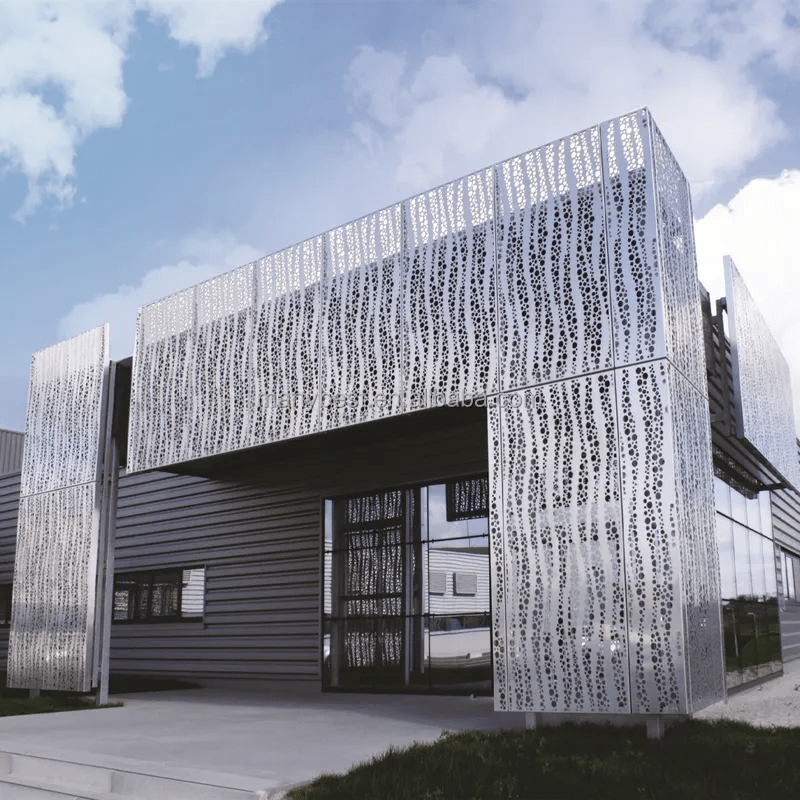In the ever-evolving world of architecture and construction, professionals are constantly seeking innovative materials and techniques to elevate their building designs. One such trend that has gained significant traction in recent years is the use of aluminum elevation panels. These panels offer a plethora of benefits, from aesthetics to durability and sustainability. In this blog, we will delve into the latest trends, techniques, and case studies surrounding the application of aluminum elevation panels in architectural projects.
I. Unveiling the Latest Trends: Elevation Panels for Building
1. Sustainable Design Solutions:
With a growing emphasis on sustainable construction practices, architects and designers are incorporating aluminum elevation panels as an eco-friendly alternative. These panels are lightweight, recyclable, and energy-efficient, making them an ideal choice for green building initiatives.
2. Customization and Versatility:
Aluminum elevation panels are available in a wide array of colors, finishes, and patterns, enabling architects to unleash their creativity and customize the building facade. From sleek and modern designs to intricate and artistic patterns, these panels offer immense versatility, making them a popular choice for architects seeking distinctive aesthetics.
3. Integration of Technology:
As technology continues to revolutionize the building industry, aluminum elevation panels are not far behind. Integration of smart systems, such as LED lighting, solar panels, and interactive displays, into these panels, has opened up new possibilities for creating dynamic and interactive facades.
II. Cutting-Edge Techniques: Elevation Panels for Building
1. Advanced Manufacturing Processes:
Manufacturers like Foshan Manybest Building Material Co., Ltd have embraced advanced manufacturing techniques to enhance the quality and precision of aluminum elevation panels. Computer Numerical Control (CNC) machining, laser cutting, and 3D printing technologies allow for intricate detailing and complex geometric designs, pushing the boundaries of architectural expression.
2. Unitized Panel Systems:
To streamline the installation process and ensure optimal performance, unitized panel systems are gaining popularity. These pre-fabricated panels are assembled off-site and then transported to the construction site for quick and efficient installation. This technique saves time, minimizes errors, and improves the overall quality of the building envelope.

III. Inspiring Case Studies: Elevation Panels for Building
1. The Shard, London, United Kingdom:
The iconic Shard skyscraper, designed by architect Renzo Piano, showcases the dramatic use of aluminum elevation panels. The panels not only provide a sleek and reflective appearance but also contribute to the building’s energy efficiency by reducing heat gain and improving insulation.
2. MahaNakhon Tower, Bangkok, Thailand:
The MahaNakhon Tower, designed by Ole Scheeren, features a distinctive pixelated facade created using aluminum elevation panels. This unique design has become a visual landmark, highlighting the possibilities of using aluminum panels to create stunning and unconventional architectural forms.
3. Apple Park, Cupertino, California, USA:
The spaceship-like headquarters of Apple Inc., designed by Foster + Partners, incorporates large-scale aluminum elevation panels into its circular structure. The panels, with their seamless and minimalistic appearance, provide a cohesive and contemporary look to the entire campus.
Ⅳ. Exploring the Versatility of Aluminum Elevation Panels for Building:
1. Flat Aluminum Panel: Lightweight and Strong
The flat aluminum panel is a popular choice among architects due to its lightweight nature, fine stiffness, and high strength. This depth-processed series of aluminum cladding ensures that buildings maintain their structural integrity while benefiting from reduced weight. These panels offer versatility in design, making them suitable for a wide range of architectural styles.
2. Shaped Aluminum Panel: Aesthetic Appeal and Durability
Architectural cladding and construction projects often turn to shaped aluminum panels for their numerous benefits. These panels are lightweight, durable, and offer exceptional aesthetic appeal. They can be customized into various shapes and designs, allowing architects to create visually striking facades. With Foshan Manybest Building Material Co., Ltd’s shaped aluminum panels, architects have a versatile solution that combines functionality with eye-catching designs.
3. Punching Aluminum Panel: Visual Effects with CNC Perforation
CNC perforation technology enables the creation of punching aluminum panels in different sizes and designs. By using various punching patterns, architects can generate a range of visual effects on building facades. Foshan Manybest Building Material Co., Ltd’s punching aluminum panels allow for intricate and unique designs that add depth and character to the architecture. This option opens up endless possibilities for creating captivating and engaging building exteriors.
4. Column Aluminum Panel: Elegance and Grandeur
Commonly found in hotels, large stations, airports, and public places, column aluminum panels exude elegance and grandeur. These panels come in two-column variations: square and round. The column aluminum panels offered by Manybest Building Material Co., Ltd enhance the overall aesthetic of buildings while providing strength and durability. Architects can rely on these panels to create visually stunning and structurally sound exteriors.
5. Art Carving Aluminum Panel: Intricate Design Possibilities
Art carving aluminum panels offer a wide range of carving pattern alternatives, such as floral designs, leaf motifs, and character images. Unlike punching aluminum panels, art carving panels provide architects with more intricate design options. Foshan Manybest Building Material Co., Ltd’s art-carving aluminum panels are a perfect choice for projects that require a touch of artistry and uniqueness, adding a distinct charm to the building elevation.
6. Aluminum Mesh Panel: Cost-Effective and Versatile
Aluminum mesh panels, created by expanding aluminum plates, offer versatility and cost-effectiveness. When compared to perforated metals, these panels are more affordable due to the slitting and expanding process. The expanded aluminum mesh panels from Manybest Building Material Co., Ltd provide a lightweight solution with excellent ventilation properties. They are suitable for projects that require enhanced airflow and a contemporary aesthetic.
Conclusion:
Aluminum elevation panels have revolutionized the way architects approach building design, offering an ideal combination of aesthetics, durability, and sustainability. As the demand for innovative facades continues to grow, professionals in the industry are leveraging the latest trends, techniques, and case studies to push the boundaries of architectural expression. With the advancements in manufacturing processes and the ability to integrate technology, the future of aluminum elevation panels looks promising, promising endless possibilities for creating visually stunning and sustainable buildings.



